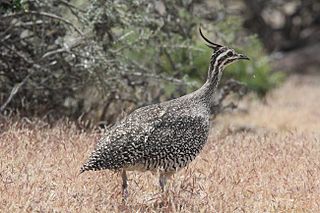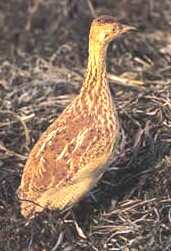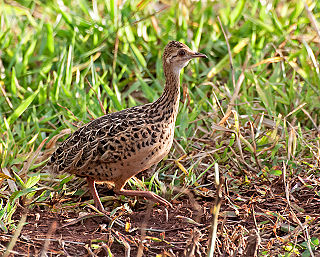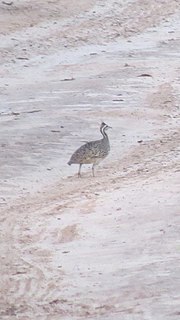
Tinamous form an order of birds called Tinamiformes, comprising a single family called Tinamidae, divided into two distinct subfamilies, containing 46 species found in Mexico, Central America, and South America. The word "tinamou" comes from the Galibi term for these birds, tinamu. Tinamous have traditionally been regarded as the sister group of the flightless ratites, but recent work places them well within the ratite radiation, implying basal ratites could fly. Tinamous first appear in the fossil record in the Miocene epoch. They are generally sedentary, ground-dwelling and, though not flightless, when possible avoid flight in favour of hiding or running away from danger. They are found in a variety of habitats, ranging from semi-arid alpine grasslands to tropical rainforests. The two subfamilies are broadly divided by habitat, with the Nothurinae referred to as steppe or open country tinamous, and the Tinaminae known as forest tinamous.

The red-winged tinamou is a medium-sized ground-living bird from central and eastern South America. Other common names for the species include perdiz grande, rufous tinamou, and ynambu.

The brown tinamou is a brownish ground bird found in humid lowland and montane forest in tropical and subtropical South America.

The Andean tinamou is a tinamou, found commonly in high-altitude shrubland, in the Andes of South America.

The puna tinamou also known as Pentland's tinamou, is a member of the most ancient groups of bird families, the tinamous. This species is native to southern South America. The binomial name of the species commemorates the Irish natural scientist Joseph Barclay Pentland (1797–1873) by Nicholas Aylward Vigors in 1837. The IUCN list this species as Least Concern, with an occurrence range of 590,000 km2 (230,000 sq mi).

The solitary tinamou is a species of paleognath ground bird. This species is native to Atlantic forest of eastern Brazil.

The Choco tinamou or Chocó tinamou is a type of tinamou found in lowland forest and montane forest in subtropical and tropical regions of Colombia and Panama.

The small-billed tinamou is a type of Tinamou commonly found in dry savanna in Amazonian South America.

The Tataupa tinamou is a type of tinamou commonly found in dry forest in subtropical and tropical regions in southeastern South America.

Taczanowski's tinamou is a type of ground bird found in the eastern Andes in Peru in the Junín, Cuzco, Apurímac, Ayacucho, and Puno Regions.

The brushland tinamou is a type of Tinamou commonly found in high-altitude dry shrubland in subtropical and tropical regions of southern South America.

The white-bellied nothura is a species of tinamou found in dry shrublands in northeastern Bolivia, western Paraguay, and northeastern Brazil.

The lesser nothura is a type of tinamou found in lowland dry grassland habitats in subtropical and tropical regions of southeastern South America.

Darwin's nothura is a type of tinamou commonly found in high-altitude grassland in the southern Andes in South America.

The spotted nothura is a species of tinamou. This bird is native to grassy habitats in eastern and southern Brazil, Paraguay, Uruguay, and eastern and northern Argentina.

The Chaco nothura is a type of tinamou commonly found in brushland in Argentina and Paraguay.

The quebracho crested tinamou is a species of tinamou found in dry forest habitats in Paraguay and northern Argentina in South America.

The Patagonian tinamou also known as Ingouf's tinamou is a member of one of the most ancient groups of paleognath birds, the tinamous. This species is native to southern South America.

The huayco tinamou, also known as waypu (Quechua), is a species of bird found on grassy mountain ridges in the Andes of Bolivia and Argentina.

Nothurinae or aridland tinamous is one of two subfamilies of the Tinamidae family, the other being Tinaminae. It contains eighteen species in six genera. The six genera are:
























